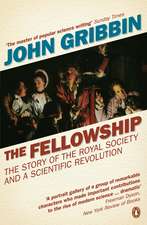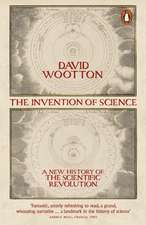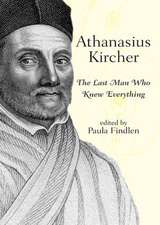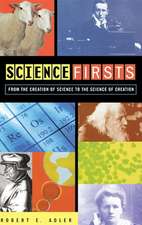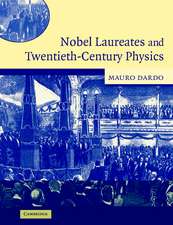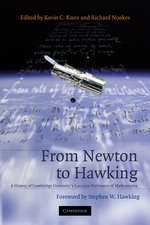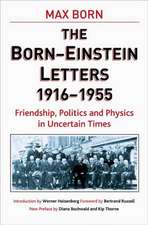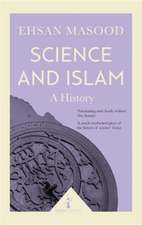The Quantum Dissidents: Rebuilding the Foundations of Quantum Mechanics (1950-1990)
Autor Olival Freire Junioren Limba Engleză Hardback – 16 ian 2015
| Toate formatele și edițiile | Preț | Express |
|---|---|---|
| Paperback (1) | 828.05 lei 6-8 săpt. | |
| Springer Berlin, Heidelberg – 6 oct 2016 | 828.05 lei 6-8 săpt. | |
| Hardback (1) | 870.62 lei 6-8 săpt. | |
| Springer Berlin, Heidelberg – 16 ian 2015 | 870.62 lei 6-8 săpt. |
Preț: 870.62 lei
Preț vechi: 1024.25 lei
-15% Nou
Puncte Express: 1306
Preț estimativ în valută:
166.62€ • 172.12$ • 138.67£
166.62€ • 172.12$ • 138.67£
Carte tipărită la comandă
Livrare economică 26 martie-09 aprilie
Preluare comenzi: 021 569.72.76
Specificații
ISBN-13: 9783662446614
ISBN-10: 3662446618
Pagini: 411
Ilustrații: XVI, 356 p. 26 illus., 14 illus. in color. With a Foreword by Silvan S. Schweber.
Dimensiuni: 155 x 235 x 27 mm
Greutate: 6.8 kg
Ediția:2015
Editura: Springer Berlin, Heidelberg
Colecția Springer
Locul publicării:Berlin, Heidelberg, Germany
ISBN-10: 3662446618
Pagini: 411
Ilustrații: XVI, 356 p. 26 illus., 14 illus. in color. With a Foreword by Silvan S. Schweber.
Dimensiuni: 155 x 235 x 27 mm
Greutate: 6.8 kg
Ediția:2015
Editura: Springer Berlin, Heidelberg
Colecția Springer
Locul publicării:Berlin, Heidelberg, Germany
Public țintă
ResearchCuprins
Dissidents and the Second Quantum Revolution.- Challenging the Monocracy of the Copenhagen School.- The Origin of the Everettian Heresy.- The Monocracy is Broken: Orthodoxy, Heterodoxy, and Wigner’s Case.- The Tausk Controversy on the Foundations of Quantum Mechanics: Physics, Philosophy, and Politics.- “From the streets into academia” – Political activism and the reconfiguration of physics around 1970.- Philosophy enters the optics laboratory: Bell’s theorem and its first experimental tests (1965–1982).- The 1980s and Early 1990s, Research on Foundations Takes Off.- Coda: Quantum Dissidents - A Collective Biographical Profile.- The Monocracy is Broken: Orthodoxy, Heterodoxy, and Wigner’s Case.- The Tausk Controversy on the Foundations of Quantum Mechanics: Physics, Philosophy, and Politics.- “From the streets into academia” – Political activism and the reconfiguration of physics around 1970.- Philosophy enters the optics laboratory: Bell’s theorem and its first experimental tests (1965–1982).- The 1980s and Early 1990s, Research on Foundations Takes Off.- Coda: Quantum Dissidents - A Collective Biographical Profile.
“From the streets into academia” – Political activism and the reconfiguration of physics around 1970.-
Philosophy enters the optics laboratory: Bell’s theorem and its first experimental tests (1965–1982).-
The 1980s and Early 1990s, Research on Foundations Takes Off.- Coda: Quantum Dissidents - A Collective Biographical Profile.
Philosophy enters the optics laboratory: Bell’s theorem and its first experimental tests (1965–1982).-
The 1980s and Early 1990s, Research on Foundations Takes Off.- Coda: Quantum Dissidents - A Collective Biographical Profile.
The 1980s and Early 1990s, Research on Foundations Takes Off.- Coda: Quantum Dissidents - A Collective Biographical Profile.
Philosophy enters the optics laboratory: Bell’s theorem and its first experimental tests (1965–1982).-
The 1980s and Early 1990s, Research on Foundations Takes Off.- Coda: Quantum Dissidents - A Collective Biographical Profile.
The 1980s and Early 1990s, Research on Foundations Takes Off.- Coda: Quantum Dissidents - A Collective Biographical Profile.
The 1980s and Early 1990s, Research on Foundations Takes Off.- Coda: Quantum Dissidents - A Collective Biographical Profile.
Philosophy enters the optics laboratory: Bell’s theorem and its first experimental tests (1965–1982).-
The 1980s and Early 1990s, Research on Foundations Takes Off.- Coda: Quantum Dissidents - A Collective Biographical Profile.
The 1980s and Early 1990s, Research on Foundations Takes Off.- Coda: Quantum Dissidents - A Collective Biographical Profile.
The 1980s and Early 1990s, Research on Foundations Takes Off.- Coda: Quantum Dissidents - A Collective Biographical Profile.
The 1980s and Early 1990s, Research on Foundations Takes Off.- Coda: Quantum Dissidents - A Collective Biographical Profile.
“From the streets into academia” – Political activism and the reconfiguration of physics around 1970.-
Philosophy enters the optics laboratory: Bell’s theorem and its first experimental tests (1965–1982).-
The 1980s and Early 1990s, Research on Foundations Takes Off.- Coda: Quantum Dissidents - A Collective Biographical Profile.
Philosophy enters the optics laboratory: Bell’s theorem and its first experimental tests (1965–1982).-
The 1980s and Early 1990s, Research on Foundations Takes Off.- Coda: Quantum Dissidents - A Collective Biographical Profile.
The 1980s and Early 1990s, Research on Foundations Takes Off.- Coda: Quantum Dissidents - A Collective Biographical Profile.
Philosophy enters the optics laboratory: Bell’s theorem and its first experimental tests (1965–1982).-
The 1980s and Early 1990s, Research on Foundations Takes Off.- Coda: Quantum Dissidents - A Collective Biographical Profile.
The 1980s and Early 1990s, Research on Foundations Takes Off.- Coda: Quantum Dissidents - A Collective Biographical Profile.
The 1980s and Early 1990s, Research on Foundations Takes Off.- Coda: Quantum Dissidents - A Collective Biographical Profile.
Philosophy enters the optics laboratory: Bell’s theorem and its first experimental tests (1965–1982).-
The 1980s and Early 1990s, Research on Foundations Takes Off.- Coda: Quantum Dissidents - A Collective Biographical Profile.
The 1980s and Early 1990s, Research on Foundations Takes Off.- Coda: Quantum Dissidents - A Collective Biographical Profile.
The 1980s and Early 1990s, Research on Foundations Takes Off.- Coda: Quantum Dissidents - A Collective Biographical Profile.
The 1980s and Early 1990s, Research on Foundations Takes Off.- Coda: Quantum Dissidents - A Collective Biographical Profile.
Recenzii
“A considerable amount of the content of this book has been published before in the form of articles, some of them coauthored. ... Among its other merits, then, The Quantum Dissidents may spur further investigations into what distinguishes work on the foundations of physics from just doing physics and what it takes for a type of scientific research to lie in the 'mainstream' of a discipline.” (Adrian Wüthrich, ISIS, Vol. 107 (2), June, 2016)
“This is a historical account of the development, controversies, and political aspects of quantum theory. … This is one of the most interesting history books available on the history and development of Quantum Mechanics. I recommend this for all students and scholars interested in this branch of Physics.” (Joseph J. Grenier, Amazon.com, May, 2016)
“The book is structured chronologically. … TheQuantum Dissidents is an impressive book and will be, perhaps ironically, foundational for further studies.” (Suman Seth, Physics Today, Vol. 69 (4), 2016)
“Several themes are consistently integrated in this book. Freire shows how the political and cultural context influenced the choice and timing of certain research topics, although he refrains from claiming that the results obtained by the researchers were also influenced. Ultimately, "The Quantum Dissidents" casts a glance on an episode of the development of quantum mechanics whose importance we have long underestimated. The interplay of the book’s different themes in fact makes it a rewarding and very pleasant read.” (Translated from French, Louis Marchildon, Physics in Canada/La Physique au Canada, Vol. 71 (4), December, 2015)
“Freire (Federal Univ. of Bahia, Brazil) tells the stories of the few physicists who dared challenge the underpinnings of quantum mechanics (QM). … Extensive footnotes and references makethis a valuable resource for further study. … Summing Up: Recommended. Graduate students through professionals/practitioners.” (M. Dickinson, Choice, Vol. 53 (2), October, 2015)
“Freire’s comprehensive history of the quantum dissidents is meticulously documented and based to a large extent on archival sources and interviews. … The quantum Dissidents is a pioneering work in the historiography of modern physics, of equal interest to historians of science, philosophers of science, and practicing physicists. I warmly recommend it.” (Helge Kragh, Science & Education, March, 2015)
“This is a historical account of the development, controversies, and political aspects of quantum theory. … This is one of the most interesting history books available on the history and development of Quantum Mechanics. I recommend this for all students and scholars interested in this branch of Physics.” (Joseph J. Grenier, Amazon.com, May, 2016)
“The book is structured chronologically. … TheQuantum Dissidents is an impressive book and will be, perhaps ironically, foundational for further studies.” (Suman Seth, Physics Today, Vol. 69 (4), 2016)
“Several themes are consistently integrated in this book. Freire shows how the political and cultural context influenced the choice and timing of certain research topics, although he refrains from claiming that the results obtained by the researchers were also influenced. Ultimately, "The Quantum Dissidents" casts a glance on an episode of the development of quantum mechanics whose importance we have long underestimated. The interplay of the book’s different themes in fact makes it a rewarding and very pleasant read.” (Translated from French, Louis Marchildon, Physics in Canada/La Physique au Canada, Vol. 71 (4), December, 2015)
“Freire (Federal Univ. of Bahia, Brazil) tells the stories of the few physicists who dared challenge the underpinnings of quantum mechanics (QM). … Extensive footnotes and references makethis a valuable resource for further study. … Summing Up: Recommended. Graduate students through professionals/practitioners.” (M. Dickinson, Choice, Vol. 53 (2), October, 2015)
“Freire’s comprehensive history of the quantum dissidents is meticulously documented and based to a large extent on archival sources and interviews. … The quantum Dissidents is a pioneering work in the historiography of modern physics, of equal interest to historians of science, philosophers of science, and practicing physicists. I warmly recommend it.” (Helge Kragh, Science & Education, March, 2015)
Notă biografică
Olival Freire, Jr. is a physicist and historian of physics. He is Associate Professor and Researcher at the Universidade Federal da Bahia, president of the Brazilian Society for the History of Science and vice-president of the Commission for the History of Modern Physics, International Union of History and Philosophy of Science.
Textul de pe ultima copertă
This book tells the fascinating story of the people and events behind the turbulent changes in attitudes to quantum theory in the second half of the 20th century. The huge success of quantum mechanics as a predictive theory has been accompanied, from the very beginning, by doubts and controversy about its foundations and interpretation. This book looks in detail at how research on foundations evolved after WWII, when it was revived, until the mid 1990s, when most of this research merged into the technological promise of quantum information. It is the story of the quantum dissidents, the scientists who brought this subject from the margins of physics into its mainstream. It is also a history of concepts, experiments, and techniques, and of the relationships between physics and the world at large, touching on themes such as the Cold War, McCarthyism, Zhdanovism, and the unrest of the late 1960s.
Caracteristici
Traces foundational upheavals in quantum mechanics from its post-war revival due to David Bohm to the start of the quantum information era Makes fascinating connections to political and cultural issues of the times Author an emininent historian of quantum physics, whose previous works have won acclaim Includes supplementary material: sn.pub/extras

